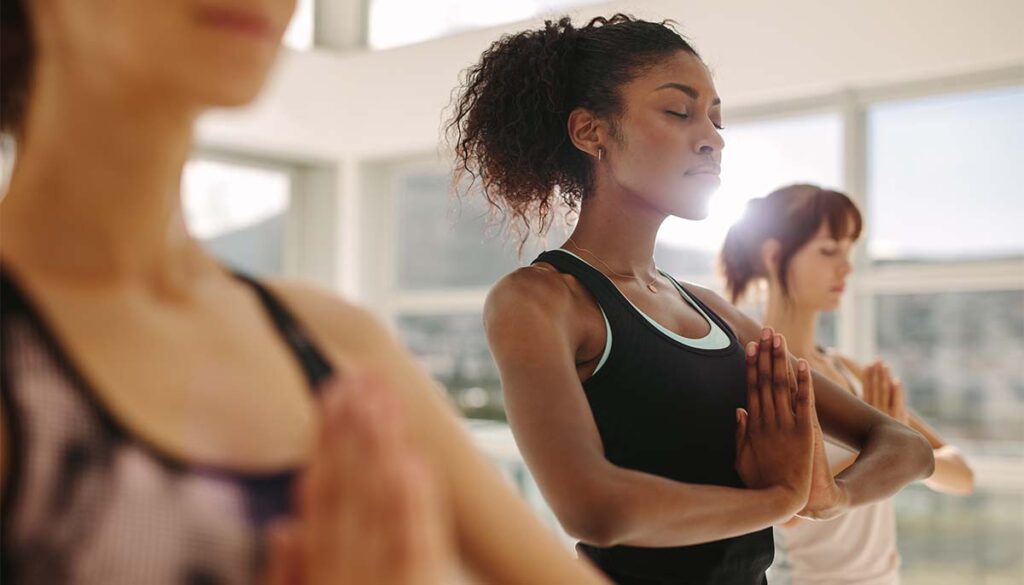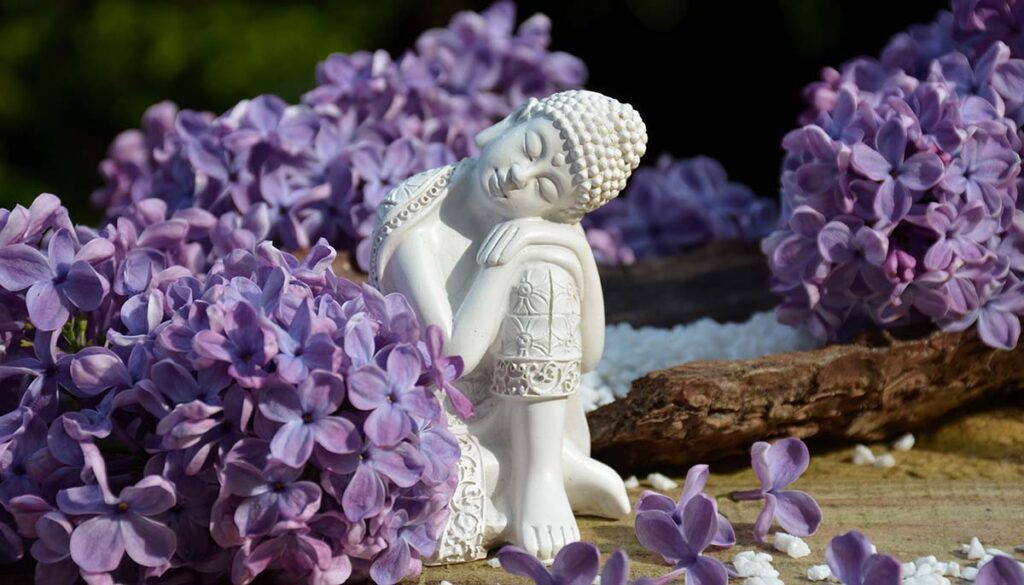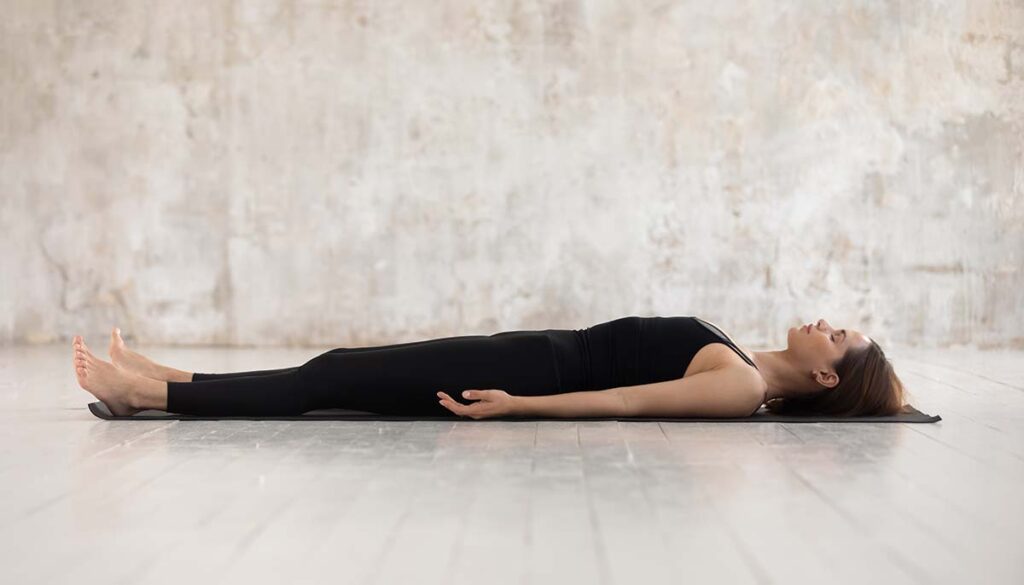There are a lot of things that can keep us up at night. Sometimes, it’s that cup of coffee we had at 4 p.m. Other times, it’s the profoundly sleeping person snoring next to us. But once in a while, it’s literally how we’re wired.
“About 60 million Americans have insomnia with more women suffering from it than men,” per Nuvanna. Often times when we’re tossing and turning, our brains just aren’t ready for bed yet. And it usually doesn’t matter how tired our bodies actually are. Whether you’re worried about something or you just can’t turn off your thoughts, quieting the mind can be nearly impossible if we’re suffering from occasional insomnia. Thankfully, various activities geared towards mental clarity and de-stressing can be added to our night time routines. And we’re here with one very helpful holistic solution.
Yoga is widely considered one of the best methods around, and it’s been relied upon for better sleep for centuries. But before we get into our first sleep-friendly pose, let’s talk about why and how it works so well.
Can Yoga Really Lead to Better Sleep?

Can yoga help us sleep better? In short, yes. And there are several science-backed reasons for it. Known for calming the mind, body, and nervous system, yoga is a wonderful way to release tension. And the more relaxed you are in every sense, the better night’s sleep you’ll be able to get.
According to one National Health Interview Survey, most people practice yoga for overall wellness reasons. Of these yogis, over 55 percent of them said they experience better sleep because of it. In general, exercise is known for being an essential way to help us sleep more soundly.
Adding any physical activity to your daily routine will benefit your sleep routine, but yoga has unique benefits. On top of working out, practicing yoga is all about mindfulness, breathing better, and stress and anxiety reduction. “You are less likely to lay awake at night with racing thoughts when you can take a step back and observe your thoughts rather than being consumed by them,” per Byrdie.
On top of that, one goal in yoga is to focus entirely on each movement, one by one. This allows you to give your undivided attention to what you’re doing, letting everything else you might otherwise be focusing on fade away. Ultimately, yoga provides you with an opportunity to slow down, and if you want to get better sleep, that’s one of the most crucial steps.
The Most Sleep Friendly Types of Yoga

Some types of yoga are more sleep-oriented than others. Typically, any class you’re taking at 6 a.m. is designed to wake you up and get your blood flowing vigorously rather than calm you down. Ultimately, an intense workout will benefit your sleep quality too. But if you’re antsy at night no matter what you do during the day, you might need something a little more soothing in your practice.
Evening classes are designed a little differently. Yoga done at night is usually meant to help you center, find stillness within yourself, and release any pent-up energy you collected during the day.
Certain types of yoga are ideal for calming the body and mind. Yin Yoga, Restorative Yoga, and Yoga Nidra (also known as “yoga sleep”) are widely considered the most sleep-friendly types of yoga in existence. And if you’re looking to adopt a yoga practice that prioritizes deep relaxation over breaking a sweat, start with one of these three. In my first yin yoga class, we were encouraged to use blankets and the lights were turned down low. Long story short, almost everyone in the room fell asleep. It was like preschool nap time all over again, but way better.
Adding Yoga to Your Bed Time Routine

Incorporating yoga into your evening routine doesn’t require a huge time slot. So if you don’t have time for a lengthy practice, don’t sweat it. Just a few sleep-friendly yoga poses can go a very long way. As long as you spend time with yourself, slow down, and pay attention to your breathing, you’ll get what you need. Calming yoga and mindfulness practices are known for helping us tap into our parasympathetic nervous system. When we take a little time to do this, much-needed rest and healing can fall into place.
Experts advise doing your evening yoga practice a couple of hours before you hit the hay. And what you do afterwards is totally up to you. Some yogis say they get the most out of their practice when they take a few minutes to reflect on it immediately afterwards. You could write down how you felt and what was going through your mind. If you struggled with staying present, write that down too. The more you commit to the practice and reflect on how it’s affecting you, the more you are likely to get out of it. From there, you can go about the rest of your night from a more physically and mentally soothed place.
Now let’s talk about some easy-to-master yoga moves that may help you sleep better. And remember, if at any time you feel uncomfortable, don’t sit still and suffer. Yoga is meant for moving around; if something doesn’t feel right, you can and should adjust your position.
Always Do Your Breath Work
When it comes to calming down, breathing through it is vital. And breath work is central to every yoga practice for good reason. “Some research has found that concentrating on your breathing can ease anxiety and maybe help you sleep better. Slow, deep breathing can have several benefits for your mind and body, including: Less stress. More melatonin production,” per WebMD.
Breath work might sound like more work than it really is. At its most basic, your job is to notice your breath. However, if it’s still new to you and you want a little more guidance, here are seven effortless and amazing yoga breath exercises for breath work beginners.
Ultimately, pairing breath with movement is tried and true tool for slowing down racing thoughts, quieting the mind, and connecting with the body.
Legs on The Wall
According to yoga masters, putting your legs on the wall (with your back on the floor) activates the parasympathetic nervous system. While this pose requires very little out of you, you’ll be relieving stress and tension, and soothing your limbs.
Seated Forward Fold (Paschimottanasana)
Deep stretching is what it’s all about. “Seated forward fold provides a deep stretch for the entire back side of the body from the heels to the neck. Forward fold calms the nervous system and emotions and stimulates the reproductive and urinary systems,” per Yoga Basics.
Cat-Cow (Bitilasana Marjaryasana)
The cat-cow pose is one of the best yoga poses for a healthier spine and clearing the mind. The idea is to coordinate your breath with your movement. By doing these two movements back and forth, inhaling as you curve your lower back (cow) and exhaling while you arch your spine (cat), you’ll focus on the task at hand and naturally tune out everything else.
Standing Forward Fold (Uttanasana)
Don’t confuse forward fold with touching your toes. The point isn’t to reach for your feet with all your might. In a standing forward fold, you surrender and flop. By folding forward and letting go, you’ll be soothing your nervous system and relieving symptoms like stress and anxiety. With your knees slightly bent and your legs engaged, fold forward with your arms dangling, allowing your entire upper body to melt.
Bridge (Setu Bandha Sarvangasana)
This is an excellent pose for strengthening multiple muscle groups, and namely the back side of the body. It also opens up your heart. If you struggle to get comfortable at bedtime, you might benefit from a nightly shoulder bridge. It can alleviate back pain and significantly strengthen your lumbar over time.
Supine Twist (Supta Matsyendrasana)
Sometimes, we just need to wring ourselves out after a long day, especially if we find ourselves sitting still for too long. That’s why a supine twist can be just what the sleep doctor ordered. This gentle, seated twisting motion not only removes tension in the back but also aids digestion.
Half Pigeon Pose (Ardha Kapotasana)
A relaxing way to open the tops, this one can stimulate your digestive system and potentially relieve stress and anxiety. “Half pigeon pose is a beautiful hip and heart opening practice that opens the hips and hamstrings, stretches the lower back, hip flexors, quadriceps, pelvic, and psoas muscles,” per Tummee. Once you’ve become more flexible, you can move into a sleeping swan pose for mega-deep stretching and even deeper relaxation.
Child’s Pose
Child’s pose is one of the most relaxing yoga positions under the sun. And you’ll get no argument out of me! It calms your body, mind, and heart all at once. “Rest your chest to your thighs and stay there for six slow, deep breaths for some moments of calm. The pose helps bring the mind’s focus inward by tuning out external distractions,” per Time.
Corpse Pose (Savasana)
No matter how much I love any yoga class, my favorite part always comes at the end when the instructor says it’s time for savasana. For five minutes, you’re lying on the floor, fully relaxed, letting go of all muscle tension. “Corpse pose can help manage stress by activating the relaxation response and deactivating the stress response.” It may also help lower or regulate blood pressure.
Don’t Just Go Through The Motions

This calming activity has both mental and physical benefits. However, you can’t just do the poses and expect to reap the most outstanding results. You must be intentional with your breath and work on remaining present. If your mind wanders, bring it back to the moment you’re in. And remember, every day is different. Our sleep problems may come and go. By sticking to your sleep-friendly yoga practice consistently, it can become a healthy addition to your nighttime routine. Eventually, your mind and body will associate evening yoga with bedtime.
Last but not least, experts say to do each pose for six repetitions or hold each pose for six cycles of deep breathing.













